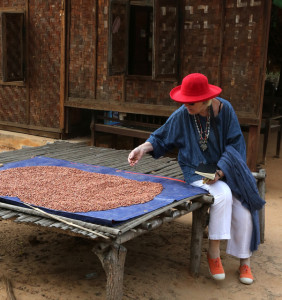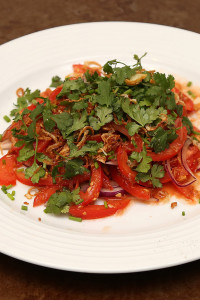I’m sitting on the balcony of the View Point Hotel in Nyaungshwe overlooking the jetty where most of the skiffs and narrow timber boats leave for Inle Lake, one of Myanmar’s biggest attractions. It’s really chilly at this time of the day. There’s two-way traffic: some boats, laden down with tomatoes, aubergines and gourds in huge bamboo baskets are on their way to the Mingalar Market in front of the pagoda. Farmers and their families sit, hunched up on the floor of the boats in woolly caps or hoodies. Up here, in the Shan Valley  away from Yangon, virtually all the men still wear the lungi, a piece of cloth, worn sarong style, like a skirt. Other slender wooden canoes fitted with long tail outboard motors have a row of little timber chairs to take tourists out onto the Inle lake. It’s 22 kilometres long and about 11 kilometres wide, bordered by the Shan mountains on either side and numerous small villages. This watery world is home to the Intha people who live in stilt houses in villages that create a fringe around the lake. They grow fruit and vegetables in floating gardens anchored to the lake bed with bamboo poles and fish with traditional Intha conical nets using a distinctive leg rowing stance on timber skiffs – fascinating to observe.
Since the 18th century, the Intha people’s way of life has gradually adapted to the climate and ecosystem. It is noisy here by the bridge with the put-put of the long tail motor engines that spew out a sheet of spray behind.
To the right, motorbikes, tricycles, lorries and cars and an occasional horse drawn wagon, clip clop over the bridge on the way to the main street. Â School girls with long plaits on their way to class. The Buddhist monks walk through the town with their bowls collecting food and alms at dawn, wandering towards the monasteries and pagodas of which there are many in this small town, which is now the principal hub for Inle lake.
I love the markets and local shops, they tell you much more about the food and culture and way of life than any guide book. I took a tricycle down to the Mingalar Market close to the entrance of the town. Both men and women stall holders sit squat – legged on raised platforms with their goods and produce beautifully displayed in front of them, up off the mud floor sometimes on rice or jute sacks or on bamboo or reed matting.
All the tropical fruit of course, papaya, mangoes, dragonfruit, loquats, guava but also an extraordinary array of greens, chickpea shoots, Burmese pennyworth, squash tendrills, watercress…
We bought rice cooked in bamboo, little red rice cakes stuffed with bean paste and some crispy ants but I stopped short of trying a barbequed rice-paddi rat despite the guide’s assurance of how delicious they were with a beer or glass of rum toddy.
Little old ladies dispensed medicinal advice on how to use the herbs and roots they were selling.
Bright plastic and stainless steel are fast replacing tin and stainless steel cooking utensils. Nonetheless, there are still wonderful handmade clay pots that keep the water cool and fresh. The area is also famous for handmade knives and kitchen utensils, I also couldn’t resist some of the light wok and handmade watering cans – try to get to Burma soon, it’s fascinating, beautiful and changing fast.
Hot Tips
Carrageen Moss
Where do I find carrageen moss? Well I found some beautiful local carrageen recently at the Village Greengrocer in Castlemartyr. I also saw several bags of the moss on the Olive Stall in the English Market in Cork City. Â Such a joy to see that this precious and health giving traditional food is still available. See www.cookingisfun.ie for recipe for Carrageen Moss pudding.
The Food Programme
For me the BBC Radio 4 Food programme is unmissable, if you don’t manage to catch it on Sunday at 12.32pm  or Monday at 15.30pm, listen back to the pod cast.
Both Seville and blood oranges are now in the shops, so check out www.slowfoodireland website for some great marmalade recipes.
Learn all about Chillies
at our next East Cork Slow Food event. Chris Young from the Irish Chilli Farm in Co Tipperary will tell share his story and how he started his chilli farm near Roscrea and the many varieties he grows
Wednesday January 27th 2016, 7pm at the Ballymaloe Cookery School.
Phone 021 4646785.
A Great Gatsby Gala Dinner
Have a fun night and support Ballycotton RNLI Lifeboat who will host a fundraising dinner on Friday February 5th 2016 at Ballymaloe House.
Drinks Reception at 7.30pm followed by dinner at 8.
Booking Essential 021 4652531.
Myanmar Chicken Curry
Use organic ingredients where possible
Serves 6
1½ lbs (700 g) free range chicken breasts
½-1 teaspoon turmeric
1 teaspoon chilli powder
2 teaspoons fish sauce, nam pla
1 teaspoon vegetable oil
Salt and freshly ground pepper
4 tablespoons sunflower or vegetable oil
2 red onions, chopped
1 teaspoon turmeric
½-1 teaspoon chilli powder
3 green cardamom, bruised
1 small knob of ginger, 15 g, chopped
2 sticks of lemongrass, finely sliced
4 cloves of garlic, chopped
1 tablespoon fish sauce, nam pla
4 ripe tomatoes, diced
8 fl oz (230 ml) chicken stock
2 stalks lemongrass, crushed, cut into 4 pieces, optional
2 tablespoons tamarind water, see recipe
Fresh coriander
Accompaniment – rice
Cut the chicken breast into 1 inch (2.5cm) pieces and put into a bowl. Sprinkle with ½-1 teaspoon of turmeric, chilli powder, fish sauce and vegetable oil. Season well with salt and freshly ground pepper. Toss and massage the meat with your fingers and allow to marinade for 30-35 minutes or while the remainder of the ingredients are prepared.
Put 4 tablespoons of oil in a wide wok or sauté pan, add the chopped red onion and cook for 2-3 minutes. Add 1 teaspoon turmeric, ½-1 teaspoon chilli powder, then add the crushed green cardamoms. Add the finely chopped ginger, sliced lemongrass and garlic. Stir and add 1 tablespoon of fish sauce and the diced tomatoes. Stir and cook for 3-4 minutes. Add the chicken cubes, toss, pour in the chicken stock and add 4 pieces of lemongrass. Add 2 tablespoons of tamarind water (if available).
Simmer gently for 6-8 minutes more or until the chicken is fully cooked and sauce is balanced and delicious but still fresh tasting. Taste and correct the seasoning. Transfer to a warm serving dish. Sprinkle with fresh coriander.
Serve with sticky rice or Basmati rice.
Note, if tamarind water is not available, taste and sharpen with some freshly squeezed lemon or lime juice.
Â
Tamarind Water
a piece of tamarind, the size of a mandarin orange
6 fl ozs (175ml/3/4 cup of hot water
Tear a lump of tamarind about the size of a mandarin, off the block. Soak it for a minimum of 2 hours or overnight in hot water in a small non-metallic bowl or cup. (The water should cover the tamarind.)
Push the tamarind pulp through a strainer, with your clean fingers. Keep pressing until just the fibre and seeds are left in the sieve. Scrape all the pulp from the outside of the sieve. Use extra water, if necessary, to separate the pulp from the fibres. Discard the seeds and fibre.
Burmese Tomato Salad
The Burmese include 1/3 teaspoon of ‘chicken seasoning’ which I prefer to omit.
Serves 2
2-3 ripe tomatoes, depending on size
1 teaspoon fish sauce
2 teaspoons toasted garlic oil
2 tablespoons crushed roasted peanuts
1 small red shallot or ½ red onion, thinly sliced
2 -3 tablespoons crispy shallot rings
Freshly squeezed lime juice, from one cheek of lime
Toasted Garlic Oil
4 fl ozs (125 ml) olive oil
12 garlic cloves
Chives, chopped
Fresh coriander sprigs
To make the toasted garlic oil. Finely chop the garlic, put in a small saucepan with the olive oil. Put on a low medium heat for 4-5 minutes and cook until the garlic is light and golden brown. If the garlic gets too dark both the garlic and oil will be too bitter.
Just before serving, half the tomatoes. Thinly slice the tomatoes sideways into julienne. Sprinkle with 1 teaspoon of fish sauce, 2 teaspoons toasted garlic oil, crushed peanuts, thinly sliced red onion and half the crispy shallots. Squeeze the juice from one cheek of lime, toss well. Season with salt and freshly ground pepper. Taste and correct the seasoning.
Pile onto a plate, garnish with fresh coriander, chopped chives and the remainder of the crispy shallots. Serve ASAP.
Burmese Night Market Noodles
The direct translation of this dish is cooked oil noodles, but I tend to associate it with the night market in Rangoon because this was the place where my brother and I often went to eat a bowl of these noodles tossed in garlic oil. It usually came with some shredded meat and a bowl of hot chicken soup sprinkled with spring onions. Nowadays whenever I have leftover roast meat, I rustle up these noodles which go down really well.
Serves 2
Cooking time 10 minutes
250 g fresh egg noodles
3 garlic cloves, thinly sliced
3 tablespoons peanut oil
1 tablespoon light soy sauce
Small handful of spring onions, chopped
Eat with
Shredded roast duck, chicken or pork
Chicken soup
Bring a large pan of water to the boil. Add a pinch of salt and blanch the noodles for a couple of minutes until they are soft. Drain and rinse under cold water. If you are using dried egg noodles, follow the packet instructions.
Heat the oil in a wok and fry the garlic until golden. Remove from the oil immediately and drain on kitchen paper. Add the noodles and soy sauce, and then toss for a minute until the noodles are warmed through and coated with the garlic oil. Check for seasoning and sprinkle with crispy garlic and spring onions. Serve with shredded meat and a bowl of soup.
From has*ba – Burmese Cookbook by Tin Cho Chaw
Burmese Caramelised Crispy Pancakes
Makes 10-12 pancakes
This is a sweet crispy stick golden pancake that reminds me of brandy snaps. The pancakes are extremely soft and sticky during cooking and transform into chewy caramelised discs when they are cool.
60 g sticky/glutinous rice flour
20 g rice flour
125 ml water
100 g palm sugar (or brown sugar)
4 tablespoons water
Peanut oil for shallow frying
Put both flours in a mixing bowl; mix in the water to form a thick batter. Leave to rest for 20 minutes while preparing the sugar.
If you are using palm sugar, grate it before placing in a small saucepan. Add 4 tablespoons of water and over a moderate heat stir until the sugar has completely dissolved. Remove from the heat and allow the sugar to cool. Gradually pour the sugar into the batter to form a consistency similar to single cream.
When you are ready to fry the pancakes, heat enough oil to shallow fry in a small non stick frying pan. Spoon a small ladle of batter into the oil and swirl the batter into the pan to form a circular shape.
Leave the pancake over a moderate heat until the edges are golden brown, then carefully flip over and cook the other side. When it is golden brown on both sides, remove from the heat and cool on a plate. The pancake remains soft and sticky until it is cool. Repeat this process making one pancake at a time until all the batter is used up, replenishing the oil when necessary.
From has*ba – Burmese Cookbook by Tin Cho Chaw


